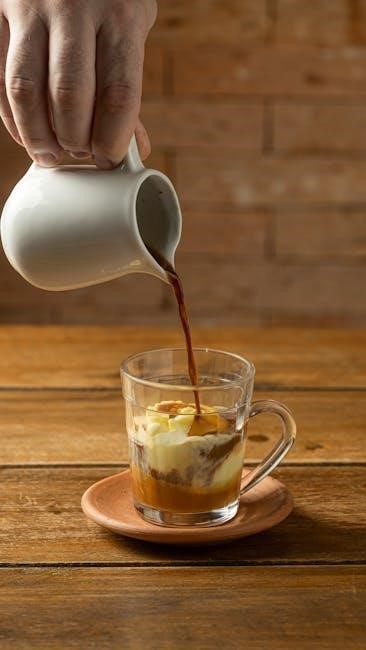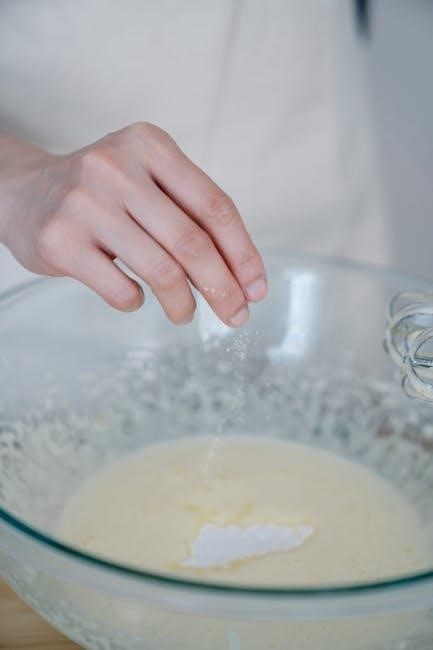land o lakes milk replacer mixing instructions
Achieving optimal results with Land O Lakes milk replacer relies heavily on precise mixing techniques․ This ensures the young animals receive a consistent and nutritionally balanced diet․ Proper mixing is essential for healthy growth and development in calves, lambs, and goats․
Importance of Accurate Mixing
Accurate mixing of Land O Lakes milk replacer is paramount for the health and development of young animals․ Consistent mixing ensures each feeding provides the correct balance of proteins, fats, carbohydrates, vitamins, and minerals, as specified in the guaranteed analysis․ Deviations from the recommended mixing ratios can lead to nutritional imbalances, impacting growth rates, immune function, and overall well-being․
Under-concentration, resulting from too little powder or too much water, can lead to inadequate nutrient intake, causing slow growth, weakness, and increased susceptibility to disease․ Conversely, over-concentration, due to excessive powder or insufficient water, can cause digestive upset, dehydration, and potentially life-threatening complications․
Furthermore, accurate mixing ensures the milk replacer dissolves completely, preventing clumping and ensuring the mixture is easily digestible․ Consistent mixing practices also aid in standardizing feeding protocols, allowing for more reliable monitoring of animal health and performance․ By adhering to the recommended mixing guidelines, you can maximize the benefits of Land O Lakes milk replacer and contribute to the healthy development of your animals․
Guaranteed Analysis and Ingredient List
Every bag of Land O Lakes milk replacer includes a tag displaying the Guaranteed Analysis and Ingredient List․ The Guaranteed Analysis outlines the minimum percentages of key nutrients, such as crude protein and crude fat, along with other vitamins and minerals․ For example, a Land O Lakes milk replacer might be labeled as a 28:20, indicating 28% protein and 20% fat․
The ingredient list details the components used in the milk replacer formulation․ These ingredients are carefully selected to provide a balanced nutritional profile suitable for specific animal needs․ The ingredient list also provides valuable insights into the product’s composition․
Understanding both the Guaranteed Analysis and Ingredient List is crucial for making informed decisions about animal nutrition․ This information allows producers to compare different milk replacers, ensuring they select a product that meets the specific requirements of their animals․ By carefully reviewing these details, you can optimize animal health and performance․
Recommended Water Temperature
The ideal water temperature plays a vital role in effectively mixing Land O Lakes milk replacer․ The generally recommended water temperature for mixing Land O Lakes milk replacer falls between 110-120 degrees Fahrenheit (43-49 degrees Celsius)․ Maintaining this temperature range is crucial for achieving optimal dissolution of the powder, preventing clumping, and ensuring a smooth, consistent mixture․
Using water that is too cold can hinder the dissolving process, leading to undissolved clumps of powder․ Conversely, water that is excessively hot can denature proteins and potentially reduce the nutritional value of the milk replacer․
Furthermore, the water temperature influences the final feeding temperature․ Starting with water in the 110-120 degrees Fahrenheit range helps ensure the milk replacer is near the ideal feeding temperature of around 100-105 degrees Fahrenheit (38-41 degrees Celsius) when delivered to the animal․ This temperature is crucial for palatability and proper digestion․
Step-by-Step Mixing Guide
To ensure consistent and effective mixing of Land O Lakes milk replacer, follow these steps meticulously․ First, gather all necessary supplies: Land O Lakes milk replacer powder, clean mixing container, accurate scale, thermometer, and water heated to the recommended temperature (110-120°F or 43-49°C)․
Begin by accurately weighing the milk replacer powder using the scale․ Refer to the product label for the specific mixing ratio for the animal you are feeding (calves, lambs, or goats)․ Precise measurement is crucial for providing the correct nutrient concentration․

Next, pour the measured amount of warm water into the clean mixing container․ Gradually add the weighed milk replacer powder to the water while continuously stirring with a wire whisk or power mixer․ Continue mixing until the powder is fully dissolved and the mixture is smooth and free of clumps․

Finally, verify the temperature of the reconstituted milk replacer using a thermometer․ If necessary, adjust the temperature to the ideal feeding range (around 100-105°F or 38-41°C) before feeding the animal․
Weighing the Powder
Accurate measurement of Land O Lakes milk replacer powder is paramount for optimal animal nutrition․ Relying on volume-based measurements, such as scoops or cups, can lead to inconsistencies in the concentration of nutrients delivered to the animal․ Weighing the powder ensures precision and consistency in every feeding․
To weigh the powder accurately, use a calibrated digital scale․ Place a clean, dry container on the scale and tare it to zero․ Gradually add the milk replacer powder to the container until the desired weight is reached, as specified on the product label for the target animal (calf, lamb, or goat)․
For Land O Lakes Herd Maker, a growth calf milk replacer, follow the recommended mixing ratios carefully․ Consistent weighing is vital for achieving the desired growth plane of nutrition․ Remember, even slight variations in powder weight can impact the animal’s nutrient intake and overall development․
Always store the milk replacer powder in a dry place to prevent clumping and maintain its accuracy when weighed․ Prioritize weighing over volume measurements for reliable and consistent mixing․
Mixing Powder and Water
The process of combining Land O Lakes milk replacer powder with water is critical for creating a homogenous and easily digestible solution․ The ideal water temperature for mixing is between 110-120 degrees Fahrenheit (43-49 degrees Celsius)․ This temperature range ensures proper dissolution of the powder, preventing clumping and maximizing nutrient availability․

Start by measuring the appropriate amount of warm water into a clean mixing container․ Gradually add the pre-weighed milk replacer powder to the water while continuously stirring․ Use a wire whisk or a power mixer for larger batches to ensure thorough mixing․
Continue mixing until the powder is completely dissolved and no clumps or floating bits remain․ Ensure the mixture is smooth and consistent in texture․ Avoid over-mixing, as this can create excessive foam․ Allow the mixture to settle for a few minutes before feeding․
For Land O Lakes Ultra Fresh Lamb Milk Replacer, follow the specific mixing ratio of 1/4 lb (1 level cup) in 1 pint of warm water․ Begin feeding with 4-6 feedings and gradually reduce until the lambs are weaned․
Batch Mixing Recommendation
Batch mixing Land O Lakes milk replacer is a practical approach, especially when feeding multiple animals․ This method involves preparing a larger quantity of milk replacer at once, streamlining the feeding process and ensuring consistency across servings․ However, it is crucial to follow specific guidelines to maintain the quality and freshness of the mixed solution․
When batch mixing, use a clean and sanitized container to prevent contamination․ Calculate the total amount of milk replacer and water needed based on the number of animals and their individual feeding requirements․ Mix the powder and water thoroughly, following the recommended temperature range of 110-120 degrees Fahrenheit (43-49 degrees Celsius)․
Store the mixed milk replacer in a refrigerated container at a temperature between 35-40 degrees Fahrenheit (2-4 degrees Celsius)․ It is recommended to use the mixed solution within 24 hours to ensure optimal freshness and nutrient content․ Before each feeding, gently re-mix the solution and check the temperature to ensure it is within the ideal feeding range․
For large batches, use 1․5 pounds of powder with water to make 1․14 gallons․
Ideal Feeding Temperature
Maintaining the correct feeding temperature for Land O Lakes milk replacer is crucial for optimal digestion and nutrient absorption in young animals․ The ideal feeding temperature is around 100-105 degrees Fahrenheit (38-41 degrees Celsius)․ This temperature range mimics the natural temperature of milk and helps ensure that the milk replacer is readily accepted and easily digested by the animal;
Feeding milk replacer that is too cold can lead to digestive upset, reduced nutrient absorption, and increased susceptibility to illness․ Conversely, feeding milk replacer that is too hot can scald the animal’s mouth and esophagus, causing discomfort and potentially long-term damage․ It is important to use a reliable thermometer to accurately measure the temperature of the milk replacer before each feeding․
If the milk replacer is too cold, gently warm it in a warm water bath or using a bottle warmer․ Avoid using a microwave, as this can create hot spots and uneven heating․ If the milk replacer is too hot, allow it to cool down naturally or add a small amount of cold water to reach the desired temperature․
For best mixing, continuously stir with wire whip or power mixer while adding powder to 110-120F Begin feeding milk replacer on day 2
Specific Product Mixing Ratios (Herd Maker)
Land O Lakes Herd Maker calf milk replacer requires precise mixing ratios to ensure optimal nutrition and growth for calves․ The recommended mixing ratio is typically 0․75 pounds of powder per 2․3 quarts of water, fed twice daily․ For the first week of life, a slightly lower concentration of 0․625 pounds of powder per 2 quarts of water is recommended․
For larger batches, mix 1․5 pounds of powder with water to make 1․14 gallons․ This ensures that each calf receives the appropriate amount of nutrients for healthy development․
It’s important to use a calibrated scale for weighing the powder rather than relying on cups or scoops․ Accurate measurements are essential to ensure that the calves receive the proper nutrients․
For best mixing, continuously stir with wire whip or power mixer while adding powder to 110-120F Begin feeding milk replacer on day 2 and provide fresh clean low sodium water along with a high quality palatable calf starter on a free-choice basis
This calf milk replacer comes with specific directions on how to mix up a bottle for your calf․
Specific Product Mixing Ratios (Lamb Milk Replacer)
Land O Lakes Ultra Fresh Lamb Milk Replacer requires specific mixing ratios to provide lambs with the necessary nutrients for healthy growth․ The recommended ratio is 1/4 lb (1 level cup) of powder mixed with 1 pint of warm water․ This concentration ensures that lambs receive the appropriate balance of protein and fat․
Begin feeding lambs this mixture 4 to 6 times a day, gradually decreasing the frequency as they approach weaning․ This feeding schedule helps them transition from colostrum to solid feed․
It’s important to note that proper mixing is crucial for ensuring the powder dissolves completely and prevents clumping․ Always use warm water to facilitate dissolution․ A well-mixed solution ensures lambs receive a consistent and palatable diet․
This milk replacer is designed to be fed to lambs from the second day of life until weaning, providing a complete nutritional source when ewe’s milk is unavailable or insufficient․
Importance of Water Quality (Low Sodium)
Water quality plays a crucial role in the health and well-being of young animals, especially when using milk replacers․ Using low-sodium water, ideally with a sodium content of less than 50 parts per million (ppm), is highly recommended when mixing Land O Lakes milk replacers․
High sodium levels in water can disrupt the electrolyte balance in young animals, leading to dehydration, diarrhea, and other health issues․ Calves, lambs, and goats are particularly sensitive to sodium imbalances, making it essential to use water that meets specific quality standards․
Before mixing milk replacer, test your water source to determine its sodium content․ If the sodium levels are too high, consider using an alternative water source, such as distilled or reverse osmosis water․
Maintaining optimal water quality ensures that young animals receive the full benefits of the milk replacer without the risk of sodium-related health complications․ Always prioritize low-sodium water for mixing and feeding to promote healthy growth and development․
Considerations for Different Animal Types (Calves, Lambs, Goats)
When using Land O Lakes milk replacers, it’s essential to consider the specific nutritional needs of different animal types, such as calves, lambs, and goats․ Each species has unique requirements for protein, fat, and other essential nutrients to support optimal growth and development․
Calves, for instance, benefit from milk replacers like Land O Lakes Herd Maker, which is formulated to promote a balanced growth plane․ Lambs may thrive on Ultra Fresh Lamb Milk Replacer, designed with a higher fat content to meet their energy demands․ Goats can utilize specialized kid milk replacers tailored to their digestive systems and growth patterns․

Always refer to the product-specific mixing ratios and feeding instructions provided by Land O Lakes․ These guidelines take into account the specific needs of each animal type, ensuring that they receive the appropriate concentration of nutrients in their milk replacer․
Paying close attention to these species-specific considerations will help maximize the benefits of Land O Lakes milk replacers and support the healthy development of your young animals․
